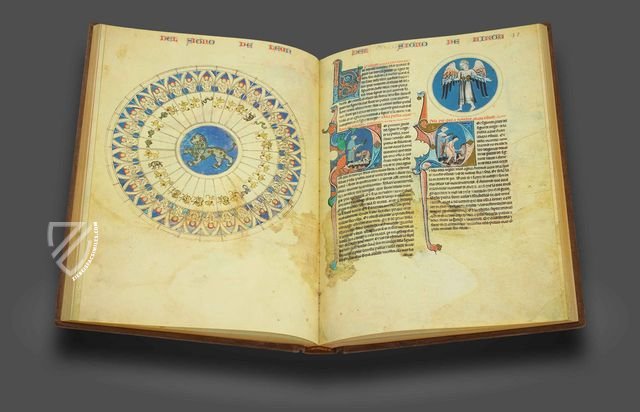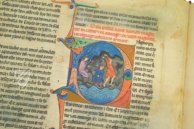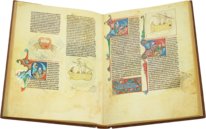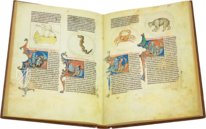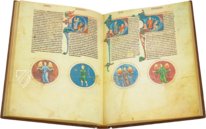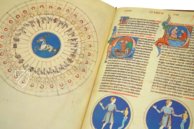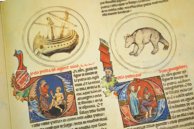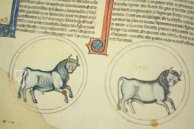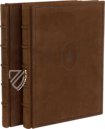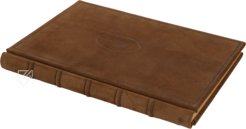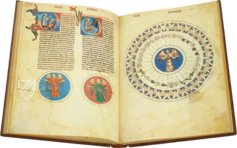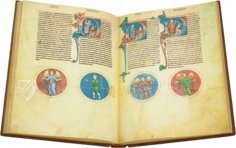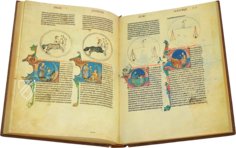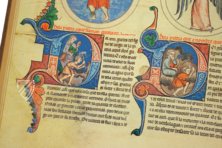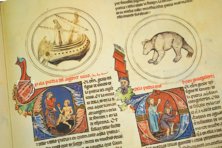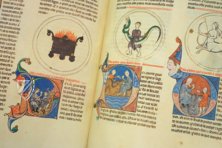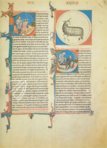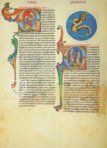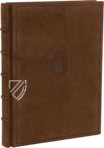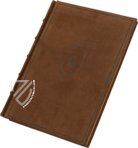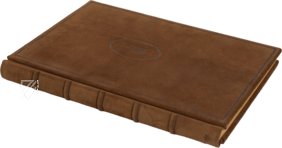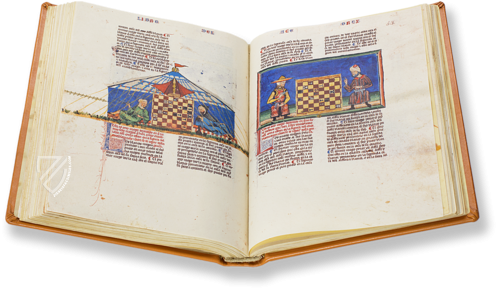Lapidary of Alfonso X the Wise
(3,000€ - 7,000€)
King Alfonso X of Castile (1221–1284) earned his epithet ‘the Wise’ because of his enthusiasm for the arts and sciences. A special testimonial to his fame as a scholar is this manuscript from 1253 known as the Lapidary of Alfonso X the Wise. The treatise, commissioned by the king and translated into Castilian by his personal physician and court astronomer Alfonso of Yehuda ben Moshe, deals with the magical and medical importance and effects of gems and other stones and relates them to astrology. Accordingly, the precious manuscript is adorned with elaborate diagrams and hundreds of astrological miniatures combined with intriguing historiated initials showing the mining and quarrying of the magical stones. This extraordinarily splendidly illuminated lapidary is now kept in the library of El Escorial and is a beautiful testimony to the intellectual court culture under Alfonso the Wise.
Lapidary of Alfonso X the Wise
Zodiac signs, constellations, heavenly bodies and their movements: the science of astrology was an ambitiously practiced field of research. Theories both new and forgotten were thought out and investigated with respect to ancient authors before they were finally recorded in precious manuscripts. The connection with minerology was a particular area of this work with astrological phenomena. In the so-called lapidaries – scientific treatises on this theme – the importance and effect of stones and gems and their relationship to astrology was recorded. This lapidary was among a number of works that Alfonso had translated from Arabic and Hebrew into Latin and Castilian by Yehuda ben Moshe, a Rabbi, astronomer, and personal physician to the King.
The Learned King as Author
Even King Alfonso the Wise occupied himself with this field of research lying between astrology and the natural sciences. The Castilian King Alfonso X (1221–1284) earned his epithet because of his fame as a scholar. He was an enthusiastic scholar and poet, who came into contact with numerous new fields of knowledge through the Moors in particular. Alfonso X not only founded a school for translators in Toledo and was a patron of art and science, but was also himself the author of a few papers and books. As a result, his thematic areas ranged from history, cosmology, and philosophy to astronomy and mathematics.
A Gorgeous Manuscript between Art and Science
The manuscript with the Lapidary of Alfonso X the Wise originated in 1253. Having said this, the impressive parchment manuscript amazes not only with of its substantial scholarly content, but also with its exceptionally beautiful artistic design. The exuberant illumination consists of luminously colorful miniatures, which visualize the theories in gorgeously ornamental depictions, e.g. with astrological tables. Additionally, artful historiated initials can be found with gorgeous scenic depictions, and at the beginning of the manuscript, there is a miniature of its presentation to the King.
Codicology
- Alternative Titles
- Primer Lapidario del Rey Alfonso X El Sabio
Lapidarium von König Alfons dem Weisen
Lapidario del Rey Alfonso X - Size / Format
- 94 pages / 40.2 × 29.1 cm
- Origin
- Spain
- Date
- 1253
- Style
- Language
- Script
- Gothic Textura Quadrata Gothic Textura Rotunda Gothic Textura Semiquadrata
- Illustrations
- 638 colorful miniatures and initial letters
- Content
- A summa of Greek, Hellenistic and Arabic treatises probably compiled by the royal physician and prominent astronomer Yehuda ben Moshe
- Patron
- King Alfonso X of Castile (1221–84) "The Wise"
- Previous Owners
- King Philip II of Spain (1527–1598)
Don Diego de Mendoza
Lapidary of Alfonso X the Wise
Attending a Lecture
The outer wall of a Gothic building with pointed arches has been removed to reveal a room with columns adorned with gold leaf, which is full of students sitting on the ground and packed shoulder to shoulder. Each holds a closed book and rests their heads on their hands as they listen intently. The varying hats they wear indicates that the audience is composed of Christians, Jews, and Muslims. Seated on a throne, the instructor holds an open book in his left hand while gesturing with his right.
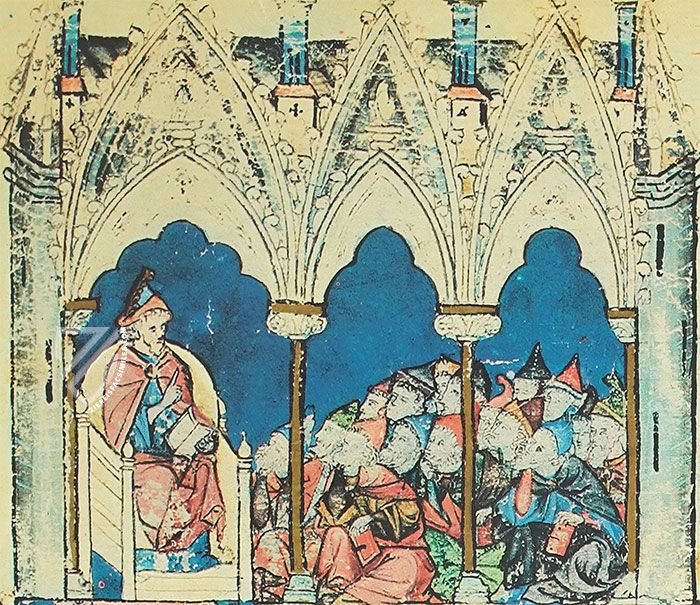
Lapidary of Alfonso X the Wise
Aries
The purpose of this astrological lapidary is to establish a connection between various zodiac signs and gemstones that were believed to have medical applications. Therefore, each page displaying a different zodiac sign shows people mining for the precious and semi-precious gemstones whose effects are supposedly supplemented during the “reign” of that sign.
Aries, whose symbol is the ram, is the first sign of the zodiac and begins with the March equinox. Although the diamond is most closely associated with Aries, it was also believed that topaz, sapphire, jasper, bloodstone, aquamarine, clear quartz, amethyst, and aventurine would be positively affected by this fire sign and would have been collected by the wealthy who were born under it.

#1 Lapidario de Alfonso X el Sabio
Language: Spanish
(3,000€ - 7,000€)
- Treatises / Secular Books
- Apocalypses / Beatus
- Astronomy / Astrology
- Bestiaries
- Bibles / Gospels
- Chronicles / History / Law
- Geography / Maps
- Saints' Lives
- Islam / Oriental
- Judaism / Hebrew
- Single Leaf Collections
- Leonardo da Vinci
- Literature / Poetry
- Liturgical Manuscripts
- Medicine / Botany / Alchemy
- Music
- Mythology / Prophecies
- Psalters
- Other Religious Books
- Games / Hunting
- Private Devotion Books
- Other Genres
- Afghanistan
- Armenia
- Austria
- Belgium
- Belize
- Bosnia and Herzegovina
- China
- Colombia
- Costa Rica
- Croatia
- Cyprus
- Czech Republic
- Denmark
- Egypt
- El Salvador
- Ethiopia
- France
- Germany
- Greece
- Guatemala
- Honduras
- Hungary
- India
- Iran
- Iraq
- Israel
- Italy
- Japan
- Jordan
- Kazakhstan
- Kyrgyzstan
- Lebanon
- Liechtenstein
- Luxembourg
- Mexico
- Morocco
- Netherlands
- Palestine
- Panama
- Peru
- Poland
- Portugal
- Romania
- Russia
- Serbia
- Spain
- Sri Lanka
- Sweden
- Switzerland
- Syria
- Tajikistan
- Turkey
- Turkmenistan
- Ukraine
- United Kingdom
- United States
- Uzbekistan
- Vatican City
- A. Oosthoek, van Holkema & Warendorf
- Aboca Museum
- Ajuntament de Valencia
- Akademie Verlag
- Akademische Druck- u. Verlagsanstalt (ADEVA)
- Aldo Ausilio Editore - Bottega d’Erasmo
- Alecto Historical Editions
- Alkuin Verlag
- Almqvist & Wiksell
- Amilcare Pizzi
- Andreas & Andreas Verlagsbuchhandlung
- Archa 90
- Archiv Verlag
- Archivi Edizioni
- Arnold Verlag
- ARS
- Ars Magna
- ArtCodex
- AyN Ediciones
- Azimuth Editions
- Badenia Verlag
- Bärenreiter-Verlag
- Belser Verlag
- Belser Verlag / WK Wertkontor
- Benziger Verlag
- Bernardinum Wydawnictwo
- BiblioGemma
- Biblioteca Apostolica Vaticana (Vaticanstadt, Vaticanstadt)
- Bibliotheca Palatina Faksimile Verlag
- Bibliotheca Rara
- Boydell & Brewer
- Bramante Edizioni
- Bredius Genootschap
- Brepols Publishers
- British Library
- C. Weckesser
- Caixa Catalunya
- Canesi
- CAPSA, Ars Scriptoria
- Caratzas Brothers, Publishers
- Carus Verlag
- Casamassima Libri
- Centrum Cartographie Verlag GmbH
- Chavane Verlag
- Christian Brandstätter Verlag
- Circulo Cientifico
- Club Bibliófilo Versol
- Club du Livre
- CM Editores
- Collegium Graphicum
- Collezione Apocrifa Da Vinci
- Comissão Nacional para as Comemorações dos Descobrimentos Portugueses
- Coron Verlag
- Corvina
- CTHS
- D. S. Brewer
- Damon
- De Agostini/UTET
- De Nederlandsche Boekhandel
- De Schutter
- Deuschle & Stemmle
- Deutscher Verlag für Kunstwissenschaft
- DIAMM
- Droz
- E. Schreiber Graphische Kunstanstalten
- Ediciones Boreal
- Ediciones Grial
- Ediclube
- Edições Inapa
- Edilan
- Editalia
- Edition Deuschle
- Edition Georg Popp
- Edition Leipzig
- Edition Libri Illustri
- Editiones Reales Sitios S. L.
- Éditions de l'Oiseau Lyre
- Editions Medicina Rara
- Editorial Casariego
- Editorial Mintzoa
- Editrice Antenore
- Editrice Velar
- Edizioni Edison
- Egeria, S.L.
- Eikon Editores
- Electa
- Emery Walker Limited
- Enciclopèdia Catalana
- Eos-Verlag
- Ephesus Publishing
- Ernst Battenberg
- Eugrammia Press
- Extraordinary Editions
- Fackelverlag
- Facsimila Art & Edition
- Facsimile Editions Ltd.
- Facsimilia Art & Edition Ebert KG
- Faksimile Verlag
- Feuermann Verlag
- Folger Shakespeare Library
- Franco Cosimo Panini Editore
- Friedrich Wittig Verlag
- Fundación Hullera Vasco-Leonesa
- G. Braziller
- Gabriele Mazzotta Editore
- Gebr. Mann Verlag
- Gesellschaft für graphische Industrie
- Getty Research Institute
- Giovanni Domenico de Rossi
- Giunti Editore
- Graffiti
- Grafica European Center of Fine Arts
- Guido Pressler
- Guillermo Blazquez
- Gustav Kiepenheuer
- H. N. Abrams
- Harrassowitz
- Harvard University Press
- Helikon
- Hendrickson Publishers
- Henning Oppermann
- Herder Verlag
- Hes & De Graaf Publishers
- Hoepli
- Holbein-Verlag
- Houghton Library
- Hugo Schmidt Verlag
- Idion Verlag
- Il Bulino, edizioni d'arte
- ILte
- Imago
- Insel Verlag
- Insel-Verlag Anton Kippenberger
- Instituto de Estudios Altoaragoneses
- Instituto Nacional de Antropología e Historia
- Istituto dell'Enciclopedia Italiana - Treccani
- Istituto Ellenico di Studi Bizantini e Postbizantini
- Istituto Geografico De Agostini
- Istituto Poligrafico e Zecca dello Stato
- Italarte Art Establishments
- Jan Thorbecke Verlag
- Johnson Reprint Corporation
- Josef Stocker
- Josef Stocker-Schmid
- Jugoslavija
- Karl W. Hiersemann
- Kasper Straube
- Kaydeda Ediciones
- Kindler Verlag / Coron Verlag
- Kodansha International Ltd.
- Konrad Kölbl Verlag
- Kurt Wolff Verlag
- La Liberia dello Stato
- La Linea Editrice
- La Meta Editore
- Lambert Schneider
- Landeskreditbank Baden-Württemberg
- Leo S. Olschki
- Les Incunables
- Liber Artis
- Library of Congress
- Libreria Musicale Italiana
- Lichtdruck
- Lito Immagine Editore
- Lumen Artis
- Lund Humphries
- M. Moleiro Editor
- Maison des Sciences de l'homme et de la société de Poitiers
- Manuscriptum
- Martinus Nijhoff
- Maruzen-Yushodo Co. Ltd.
- MASA
- Massada Publishers
- McGraw-Hill
- Metropolitan Museum of Art
- Militos
- Millennium Liber
- Müller & Schindler
- Nahar - Stavit
- Nahar and Steimatzky
- National Library of Wales
- Neri Pozza
- Nova Charta
- Oceanum Verlag
- Odeon
- Orbis Mediaevalis
- Orbis Pictus
- Österreichische Staatsdruckerei
- Oxford University Press
- Pageant Books
- Parzellers Buchverlag
- Patrimonio Ediciones
- Pattloch Verlag
- PIAF
- Pieper Verlag
- Plon-Nourrit et cie
- Poligrafiche Bolis
- Presses Universitaires de Strasbourg
- Prestel Verlag
- Princeton University Press
- Prisma Verlag
- Priuli & Verlucca, editori
- Pro Sport Verlag
- Propyläen Verlag
- Pytheas Books
- Quaternio Verlag Luzern
- Reales Sitios
- Recht-Verlag
- Reichert Verlag
- Reichsdruckerei
- Reprint Verlag
- Riehn & Reusch
- Roberto Vattori Editore
- Rosenkilde and Bagger
- Roxburghe Club
- Salerno Editrice
- Saltellus Press
- Sandoz
- Sarajevo Svjetlost
- Schöck ArtPrint Kft.
- Schulsinger Brothers
- Scolar Press
- Scrinium
- Scripta Maneant
- Scriptorium
- Shazar
- Siloé, arte y bibliofilia
- SISMEL - Edizioni del Galluzzo
- Sociedad Mexicana de Antropología
- Société des Bibliophiles & Iconophiles de Belgique
- Soncin Publishing
- Sorli Ediciones
- Stainer and Bell
- Studer
- Styria Verlag
- Sumptibus Pragopress
- Szegedi Tudomànyegyetem
- Taberna Libraria
- Tarshish Books
- Taschen
- Tempus Libri
- Testimonio Compañía Editorial
- Thames and Hudson
- The Clear Vue Publishing Partnership Limited
- The Facsimile Codex
- The Folio Society
- The Marquess of Normanby
- The Richard III and Yorkist History Trust
- Tip.Le.Co
- TouchArt
- TREC Publishing House
- TRI Publishing Co.
- Trident Editore
- Typis Regiae Officinae Polygraphicae
- Union Verlag Berlin
- Universidad de Granada
- University of California Press
- University of Chicago Press
- Urs Graf
- Vallecchi
- Van Wijnen
- VCH, Acta Humaniora
- VDI Verlag
- VEB Deutscher Verlag für Musik
- Verlag Anton Pustet / Andreas Verlag
- Verlag Bibliophile Drucke Josef Stocker
- Verlag der Münchner Drucke
- Verlag für Regionalgeschichte
- Verlag Styria
- Vicent Garcia Editores
- W. Turnowski Ltd.
- W. Turnowsky
- Waanders Printers
- Wiener Mechitharisten-Congregation (Wien, Österreich)
- Wissenschaftliche Buchgesellschaft
- Wissenschaftliche Verlagsgesellschaft
- Wydawnictwo Dolnoslaskie
- Xuntanza Editorial
- Zakład Narodowy
- Zollikofer AG

